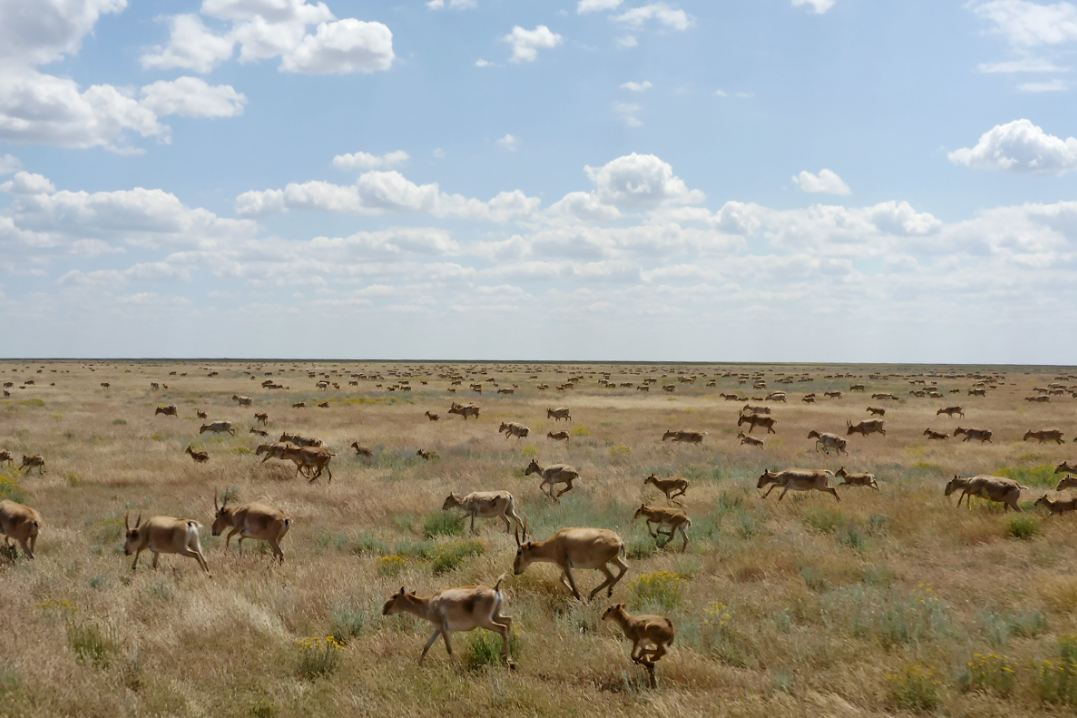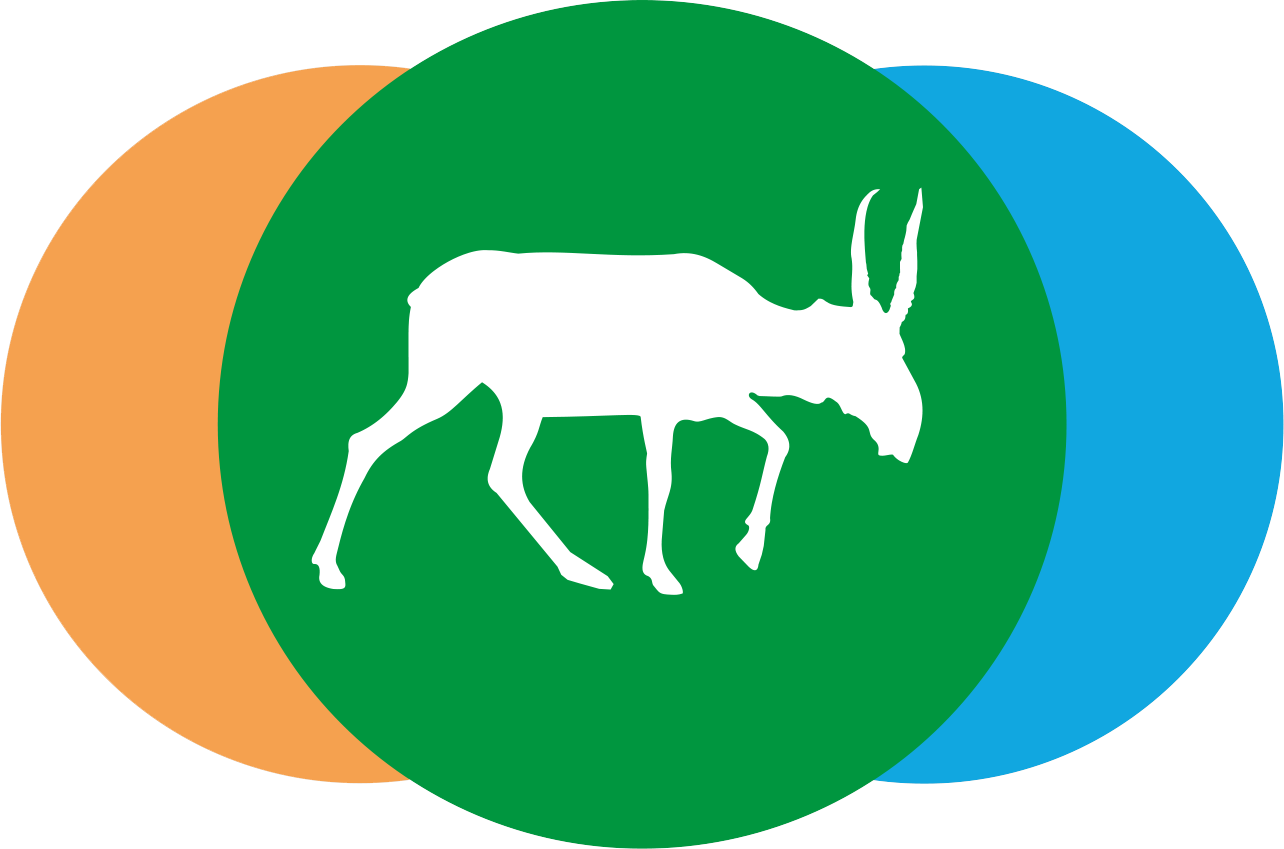Project manager: Bizhanova Nazerke Alimkyzy
Period of project framework: 2023 — 2025
IRN: AP19680227
Relevance
The negative impact of linear structures on animal populations has now become a global problem. The intensive development of the Central Asian countries, the expansion of trade between China and Europe, the development of mineral deposits necessitates the construction of roads, railways and other facilities. Transport lines cross traditional migration routes, disrupt the flow of migrations, divide habitats and often lead to direct death of animals. In Kazakhstan, in recent years, new highways and railways have been built and planned intensively, crossing the migration routes of animals. Of particular concern is their impact on saiga populations, a massive and valuable species of ungulates that regularly migrate long distances. The project is aimed at contributing to solving this problem.
The aim of the studies planned within the framework of this project is to assess and forecast the impact of existing and projected transport lines with related infrastructure facilities on saiga populations and to develop recommendations to reduce or prevent harm to animals.
To achieve this goal, the following tasks have been set within the framework of the project:
1) Conduct an analysis of the location of existing and planned roads and railways, and identify highways that cross, or will cross, migratory routes of saigas.
2) Determine the scale of the reduction in the saiga range that has occurred as a result of the construction of highways.
3) Conduct ground, aero-visual and satellite tracking of saigas during spring and autumn migrations in order to identify possible road intersections and the optimal locations and arrangement of crossings for animals.
4) Assess the scale of death of saigas on roads and railways and identify problem areas along existing transport lines.
5) Evaluate the effectiveness of the constructed earth crossings for animals through the new highways in Ustyurt and in Central Kazakhstan.
6) Explore the possibility of constructing bypass routes (when designing new roads) in some key habitat areas, in order to avoid damage to saiga populations.
7) Develop recommendations to reduce or prevent the negative impact of roads and railways on saiga populations.
Project implementers:
Scientific Director of the Project: Bizhanova Nazerke Alimkyzy, PhD, Senior Researcher, Theriology Laboratory, ORCID ID: 0000-0002-1804-2511, Scopus ID: 57874162200 h-index 2
Responsible executor: Grachev Alexey Alexandrovich, Acting Head of the Laboratory of Theriology, ORCID ID: 0000-0001-6051-8299 , Scopus ID: 57873983000 h-index 2
The staff of the laboratory of theriology of the Institute of Zoology.

Brief results of the work:
1. Analysis of threats from transport infrastructure: An analysis of departmental and own data was conducted, problematic sections of roads crossing saiga migration routes were identified. It was found that the Zhezkazgan-Sekseuildi and Shalkar-Beineu railways became a serious barrier to migration, leading to changes in traditional routes and a reduction in the length of migrations.
2. Assessment of the modern and historical range: Retrospective and modern data on changes in the saiga range were analyzed. It was confirmed that reductions occurred for various reasons: poaching, jute winters, epizootics. Since the mid-2000s, the population has begun to recover and the range has partially expanded, but it still remains mosaic.
3. Identification of factors in the reduction of the range: The role of infrastructure barriers in modern changes in the range is highlighted. Although roads previously played a secondary role, in recent years they have become a serious factor limiting migration and access to traditional wintering grounds.
4. Population size and spatial structure: Ground and aerial visual surveys of the ranges of the Ural, Ustyurt and Betpakdala saiga populations were conducted. In April 2024, participation in the annual state aerial census of saiga was taken. Data on the size and territorial distribution of populations were collected. It was established that the Shalkar-Beineu and Zhezkazgan- Sekseuildi railways seriously disrupt the migration routes of saigas.
5. Counting saiga deaths: A survey of 2,850 km of routes was conducted in the spring-summer period of 2024. 11 cases of saiga calves being killed by vehicles in the Ural population were recorded, as well as 25 cases of adult saigas being killed by trains on the Shubarkol-Kyzylzhar railway. Road death incidents were entered into a single GIS-based database, the work is ongoing.
6. Effectiveness of constructed crossings: 43 camera traps were installed on earthen crossings in Ustyurt. No saiga crossings were recorded, which indicates their ineffectiveness. Visual observations have shown that saigas do not approach the railway on Ustyurt closer than 500-1000 m, and the design features of the railway (high embankments, fences, power lines) create a visual barrier for the animals.
7. As a result of ground research and GIS analysis, taking into account the relief, migration routes and seasonal distribution, two optimal areas for arranging crossings for saigas across the Shalkar-Beineu railway on Ustyurt have been identified.
Work in all areas continues until December 2025. Based on the research results, recommendations will be developed and proposed to reduce or prevent the negative impact of roads and railways on saiga populations, including the optimal location and arrangement of crossings for animals.

List of publications:
- Grachev Yu., Bizhanova N., Grachev A. Linear transport infrastructure in saiga antelope (Saiga tatarica) habitats in Kazakhstan // 2nd International Conference on Electrical and Power Engineering ICPE-CA “ASMES 2024: Advanced structures, materials and electrical systems”. – Tulcea, Romania. – 2024. – pp. 47-48.
- Begilov T.Z., Bizhanova N.A., Eszhanov B.E., Sarsenova B.B. The current ecological state of the Volga-Ural saiga population and the problems of sustainable development of the population // Bulletin of KazNU. Ecological Series. – 2024. – Vol. 80. – No. 3. – P. 56-67. https://doi.org/10.26577/EJE.2024.v80.i3-06 (In Kazakh)
- Bizhanova N., Grachev A., Rametov N., Baidavletov Y., Saparbayev S., Bespalov M., Bespalov S., Kumayeva I., Grachev Y. Railway and Road Infrastructure in Saiga Antelope Range in Kazakhstan // Diversity, 2025. in-press.
Photos of saigas: Saparbaev S. and Bespalov S.
